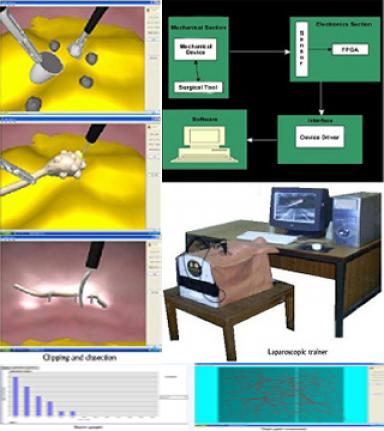Products and Technologies

Laparoscopic Surgery Training Simulator
Technology Cluster
Laparoscopic surgery is minimally in massive surgery (M15) of tl1e abdomen. It is performed with the help of surgical instruments and viewing equipment, which are inserted through small incisions of about 10 mm (conventional method requires a large incision to expose and provide access to the operation site). A small camera inserted through incision displays the site of operation on a monitor. The HIS surgeons then interact with the anatomy at geometrically- unrelated location. The display covers a considerably smaller field of view, which rt-suits in difficulties in identifying anatomical landmarks. This demands a perfect hand-to-eye coordination on the part of the surgeons. All these necessitates that the MIS surgeons are extensively trained before they use laparoscopic surgery technique.
Generally, the surgeons are trained either from the books describing the surgical procedures and techniques or in the operating theatre by watching and participating in actual operations, but rarely in animal laboratories. Virtual environment presents a good alternative to the conventional way of training. But the system must be realistic enough to produce higher realism with as little computing resource as possible, so that it can replace training on live patients.
DRDO and the Institute of Robotic and intelligence System (IRIS), Bangalore, has jointly developed a first of its kind laparoscopic Surgery Training Simulator in India. The simulator is simple-to-use and designed to teach M15 skills in a vitual scenario. It is an effective and economical tool for acquiring specialised skills a laparoscopic surgeon needs to excel in. The simulator enables the trainees to develop and refine the specific key psychomotor skills and bimanual dexterity required to become a proficient laparoscopic surgeon. The methods and tools involved are subjective and could be influenced by either the trainee or the trainer. The simulator automates the training and improves objectivity. It has successfully gone through the different stages of design, development, validation and clinical trials, and is now ready for commercialisation. The simulator comprises the following modules:
Trainer System
The mechanical trainer (the tools and its mechanical set up) is a physical black box. It comprises surgical tools and a pelvic trainer, which simulates the abdomen region. Five independent exercises for different skill sets and difficulty levels have been developed. The trainer is coupled to the virtual- reality simulator through an electronic interface.Device drivers can read the position and orientation of the surgical tools and interfacing to the virtual world from any position. The system maintains the exercises along with the personal database and performance graphs of each trainer.
Training Exercises
The training process requires the surgeon to perform a set of five exercises that helps him gain the required skills. Training exercises have been developed after extensive discussions with expert laparoscopic surgeons and by observing the actual operations at the hospitals. The exercises include 2-D selection, 3-D selection and picking, clipping and dissection, cyst puncturing, and burning.
Salient Features
- Modular in design
- Camera simulation
- Trainee database
- Scalable software
- User friendly interface
Trainees’ Performance Evaluation
The main advantage of the VR based training is the online evaluation of the individual being trained. A trainee performance evaluation performance has been developed to evaluate a trainee based on three parameters, viz., economy of distance, economy of time, and the negative marks (penalty) during the training of a particular exercise. These three parameters carry different weight age based on the importance of concerned parameter and exercise.


